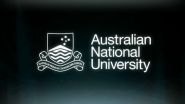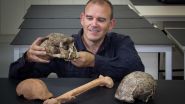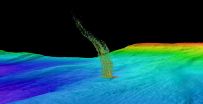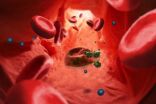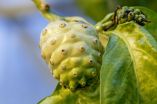(Press-News.org) An international team of scientists has discovered the earliest known engravings from human ancestors on a 400,000 year-old fossilised shell from Java.
The discovery is the earliest known example of ancient humans deliberately creating pattern.
"It rewrites human history," said Dr Stephen Munro from School of Archaeology and Anthropology at The Australian National University (ANU).
"This is the first time we have found evidence for Homo erectus behaving this way," he said.
The newly discovered engravings resemble the previously oldest-known engravings, which are associated with either Neanderthals or modern humans from around 100,000 years ago.
The early date and the location of the discovery in Java discount the possibility that the engravings could have been the work of Neanderthals or modern humans.
"It puts these large bivalve shells and the tools used to engrave them, into the hands of Homo erectus, and will change the way we think about this early human species," Dr Munro said.
It is unclear whether the pattern was intended as art or served some practical purpose.
The zig-zag pattern engravings were only recently discovered on fossilised mussel shells, which had been collected 100 years ago.
Dr Munro visited the Netherlands to study the collection, gathered by the discoverer of Homo erectus, Eugene Dubois, in Java in the late 19th Century.
However, he did not notice the markings on the fossils until he examined photographs he had taken, once back at ANU.
"It was a eureka moment. I could see immediately that they were man-made engravings. There was no other explanation," Dr Munro said.
Following the discovery, an international team worked to establish the exact date of the shell, using two different methods to arrive at the final result of between 430,000 and 540,000 years old.
VIDEO:
Dr Stephen Munro explains how 400 000 year old patterns scratched on a mussel shell have rewritten human history.
Click here for more information.
The team found that Homo erectus opened the shells by drilling a hole through the shell with a shark's tooth, exactly at the point where the muscle is attached. Damaging muscles this way causes the valves of the shell to open, so that the contents can be eaten.
"It's evidence that Homo erectus exploited these aquatic food resources, and fits with other evidence that they probably foraged in and around water," Dr Munro said.
INFORMATION:
Animals that regulate their body temperature through the external environment may be resilient to some climate change but not keep pace with rapid change leading to potentially disastrous outcomes for biodiversity.
A study by the University of Sydney and University of Queensland showed many animals can modify the function of their cells and organs to compensate for changes in the climate and have done so in the past, but the researchers warn that the current rate of climate change will outpace animals' capacity for compensation (or acclimation).
The research has just ...
SAN ANTONIO -- Use of anthracycline-based chemotherapy, a common treatment for breast cancer, has negligible cardiac toxicity in women whose tumors have BRCA1/2 mutations -- despite preclinical evidence that such treatment can damage the heart.
The findings, to be presented at the 2014 San Antonio Breast Cancer Symposium (SABCS), represent a unique effort between cardiologists and oncologists at Georgetown Lombardi Comprehensive Cancer Center and MedStar Heart & Vascular Institute in Washington to answer a vital clinical question.
"Our study was prompted by evidence from ...
SALT LAKE CITY, Utah, Dec. 9, 2014 - Myriad Genetics, Inc. (NASDAQ: MYGN) today announced results from a new study that demonstrated the ability of the myRisk™ Hereditary Cancer test to detect 105 percent more mutations in cancer causing genes than conventional BRCA testing alone. The Company also presented two key studies in triple negative breast cancer (TNBC) that show the myChoice™ HRD test accurately predicted response to platinum-based therapy in patients with early-stage TNBC and that the BRACAnalysis® molecular diagnostic test significantly predicted ...
BLOOMINGTON, Ind. -- It's widely known that the Earth's average temperature has been rising. But research by an Indiana University geographer and colleagues finds that spatial patterns of extreme temperature anomalies -- readings well above or below the mean -- are warming even faster than the overall average.
And trends in extreme heat and cold are important, said Scott M. Robeson, professor of geography in the College of Arts and Sciences at IU Bloomington. They have an outsized impact on water supplies, agricultural productivity and other factors related to human health ...
Off the West Coast of the United States, methane gas is trapped in frozen layers below the seafloor. New research from the University of Washington shows that water at intermediate depths is warming enough to cause these carbon deposits to melt, releasing methane into the sediments and surrounding water.
Researchers found that water off the coast of Washington is gradually warming at a depth of 500 meters, about a third of a mile down. That is the same depth where methane transforms from a solid to a gas. The research suggests that ocean warming could be triggering the ...
A new study from Karolinska Institutet in Sweden shows that long-term endurance training in a stable way alters the epigenetic pattern in the human skeletal muscle. The research team behind the study, which is being published in the journal Epigenetics, also found strong links between these altered epigenetic patterns and the activity in genes controlling improved metabolism and inflammation. The results may have future implications for prevention and treatment of heart disease, diabetes and obesity.
"It is well-established that being inactive is perilous, and that regular ...
Malaria parasites invade human red blood cells; they then disrupt them and infect others. Researchers at the University of Basel and the Swiss Tropical and Public Health Institute (Swiss TPH) have now developed so-called nanomimics of host cell membranes that trick the parasites. This could lead to novel treatment and vaccination strategies in the fight against malaria and other infectious diseases. Their research results have been published in the scientific journal ACS Nano.
For many infectious diseases no vaccine currently exists. In addition, resistance against ...
This news release is available in German.
In the course of evolution, animals have become adapted to certain food sources, sometimes even to plants or to fruits that are actually toxic. The driving forces behind such adaptive mechanisms are often unknown. Scientists at the Max Planck Institute for Chemical Ecology in Jena, Germany, have now discovered why the fruit fly Drosophila sechellia is adapted to the toxic fruits of the morinda tree. Drosophila sechellia females, which lay their eggs on these fruits, carry a mutation in a gene that inhibits egg production. ...
Scientists can now explore nerves in mice in much greater detail than ever before, thanks to an approach developed by scientists at the European Molecular Biology Laboratory (EMBL) in Monterotondo, Italy. The work, published online today in Nature Methods, enables researchers to easily use artificial tags, broadening the range of what they can study and vastly increasing image resolution.
"Already we've been able to see things that we couldn't see before," says Paul Heppenstall from EMBL, who led the research. "Structures such as nerves arranged around a hair on the skin; ...
Researchers found out that the conformational defect in a specific protein causes Autosomal Dominant Lateral Temporal Lobe Epilepsy (ADLTE) which is a form of familial epilepsy. They showed that treatment with chemical corrector called "chemical chaperone" ameliorates increased seizure susceptibility in a mouse model of human epilepsy by correcting the conformational defect. This was published in Nature Medicine (December 8, 2014 electronic edition).
Mutations in the gene LGI1, encoding a secreted protein, cause familial temporal lobe epilepsy. The research group of ...
